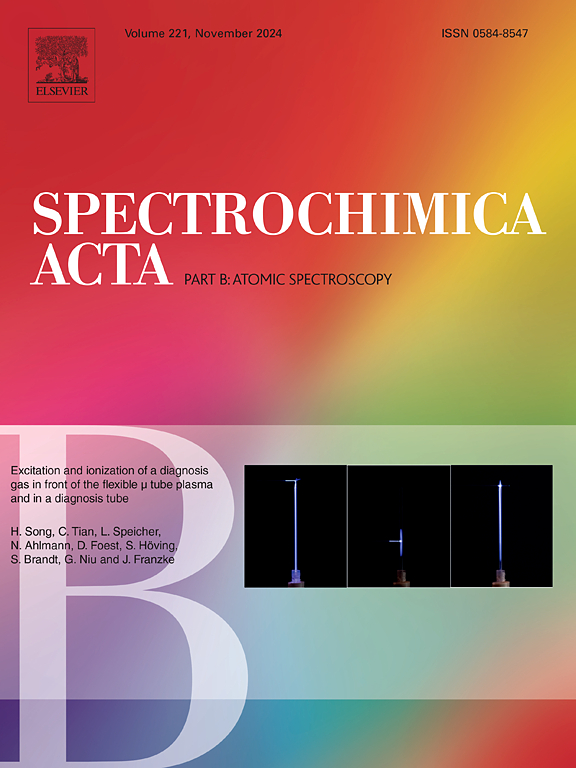Method validation and measurement uncertainty estimation in trace element determinations in water samples using total reflection X-rays fluorescence spectrometry
IF 3.2
2区 化学
Q1 SPECTROSCOPY
引用次数: 0
Abstract
This study validated a spectrometric method to determine the concentration of 8 elements such as chromium, manganese, iron, nickel, copper, zinc, arsenic and lead in water samples using total reflection X-ray fluorescence (TXRF). Method validation was conducted to determine its linearity, precision, limit of detection (LOD), limit of quantitation (LOQ), reproducibility and robustness using a certified multielement standard. A broad linear range of concentration was achieved for the elements with high coefficient of determination, R2 > 0.99, particularly the linearity of Fe and Zn extended up to 10,000 μg/L. Five replicate analyses reported high repeatability or precision with <5 % relative standard deviation. The LOD (0.88–2.37 μg/L) and LOQ (2.92–7.91 μg/L) inversely increased with the decreasing atomic number of elements. Highly reproducible results were achieved with the relative percent difference (RPD), <9 % between 2 different operators over a few weeks of testing. The spectrometer still maintained its robustness with <4 % RPD, even operating at elevated temperature at 32 °C. Method performance was verified through spiking tests in drinking water with 82.6 %–103.9 % recovery at 100–300 μg/L. Its high performance was also verified with element recoveries of 81.4 %–112.8 % at 300 μg/L in the complex matrix interference background of groundwater. The participation of proficiency testing for elements in waste water achieved satisfactory results with the z-score < 0.7. Instrument sensitivity was the main contributor of measurement uncertainty, ranging from 11.8 % to 12.8 % of the measured values. Therefore, TXRF is a fast, reliable and feasible technique for trace elemental analysis as demonstrated from its validation and verification data.

求助全文
约1分钟内获得全文
求助全文
来源期刊
CiteScore
6.10
自引率
12.10%
发文量
173
审稿时长
81 days
期刊介绍:
Spectrochimica Acta Part B: Atomic Spectroscopy, is intended for the rapid publication of both original work and reviews in the following fields:
Atomic Emission (AES), Atomic Absorption (AAS) and Atomic Fluorescence (AFS) spectroscopy;
Mass Spectrometry (MS) for inorganic analysis covering Spark Source (SS-MS), Inductively Coupled Plasma (ICP-MS), Glow Discharge (GD-MS), and Secondary Ion Mass Spectrometry (SIMS).
Laser induced atomic spectroscopy for inorganic analysis, including non-linear optical laser spectroscopy, covering Laser Enhanced Ionization (LEI), Laser Induced Fluorescence (LIF), Resonance Ionization Spectroscopy (RIS) and Resonance Ionization Mass Spectrometry (RIMS); Laser Induced Breakdown Spectroscopy (LIBS); Cavity Ringdown Spectroscopy (CRDS), Laser Ablation Inductively Coupled Plasma Atomic Emission Spectroscopy (LA-ICP-AES) and Laser Ablation Inductively Coupled Plasma Mass Spectrometry (LA-ICP-MS).
X-ray spectrometry, X-ray Optics and Microanalysis, including X-ray fluorescence spectrometry (XRF) and related techniques, in particular Total-reflection X-ray Fluorescence Spectrometry (TXRF), and Synchrotron Radiation-excited Total reflection XRF (SR-TXRF).
Manuscripts dealing with (i) fundamentals, (ii) methodology development, (iii)instrumentation, and (iv) applications, can be submitted for publication.

 求助内容:
求助内容: 应助结果提醒方式:
应助结果提醒方式:


